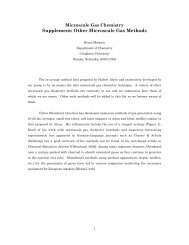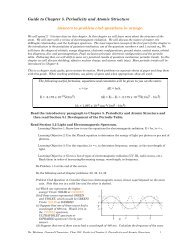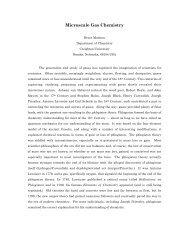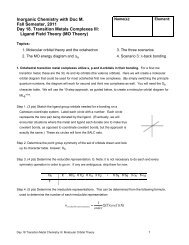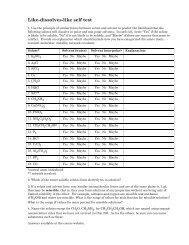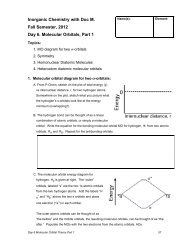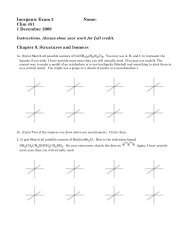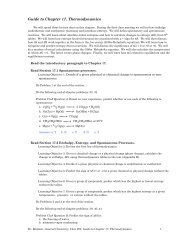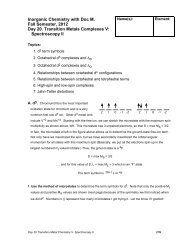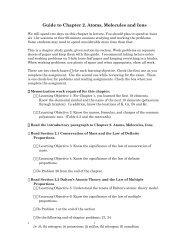Inorganic Chemistry with Doc M - Mattson
Inorganic Chemistry with Doc M - Mattson
Inorganic Chemistry with Doc M - Mattson
You also want an ePaper? Increase the reach of your titles
YUMPU automatically turns print PDFs into web optimized ePapers that Google loves.
<strong>Inorganic</strong> <strong>Chemistry</strong> <strong>with</strong> <strong>Doc</strong> M.<br />
Fall Semester, 2012<br />
Day 21. Transition Metals Complexes V:<br />
Reaction Mechanisms<br />
Topics:<br />
Name(s):<br />
1. Substitution reactions: dissociative v. associative 4. Pseudorotation<br />
Day 21. Transition Metal <strong>Chemistry</strong> VI. Reaction Mechanisms 223<br />
Element:<br />
2. Factors affecting reaction mechanisms 5. The Chelate Effect<br />
3. Stereochemistry of Reactions 6. Trans Effect<br />
A. Background/review<br />
By definition, reaction mechanisms are part of the realm of kinetics. Reactions can be fast or slow.<br />
There may be two or more steps so an intermediate is involved. (a) Sketch the reaction profile for a 1-<br />
step reaction mechanism and (b) for a two-step mechanism. In both cases, make your reactions<br />
slightly exothermic. In (b), make the first step the rate-determining step.<br />
(a)<br />
B. Substitution reactions mechanisms: octahedral complexes<br />
1. Octahedral complexes substitute ligands, one at a time:<br />
(b)<br />
ML 6 +/-n + L’ à ML5 L’ +/-n + L.<br />
In class, you saw this reaction when I tossed some aqueous ammonia into a solutions of<br />
[Co(H 2 O) 6 ]Cl 2 , [Cu(H 2 O) 6 ]Cl 2 , and [Ni(H 2 O) 6 ]Cl 2 . Write the substitution reaction that took place in<br />
each case, assuming that only one ammonia was added per metal complex ion.<br />
2. How did that ammonia come to substitute a water ligand? Did the water ligand leave first or did it<br />
leave after the ammonia ligand became attached? Or… did it leave in some other arrangement<br />
somehow — like an S N2 in organic chemistry? To explore these possibilities one at a time, we need to<br />
sketch out what must be happening.
a. Dissociative mechanism. In the first<br />
suggested reaction mechanism, where the<br />
water ligand leaves and then the ammonia<br />
ligand comes in to the vacated position, we<br />
have an intermediate that is 5-coordinate<br />
(square pyramidal). Sketch the reaction profile<br />
for the reaction in the box and include 3-D<br />
sketches of the molecules and intermediates<br />
positioned near where they relate to the reaction<br />
profile. This mechanism is called dissociative<br />
because the rate-determining step is the loss of<br />
water ligand.<br />
1. What is the reaction mechanism, step-by-step?<br />
2. The first step of the reaction mechanism is the rate-determining step. What is the rate law?<br />
b. Associative mechanism. The second<br />
suggested mechanism is called associative in<br />
which the ammonia coordinates to the metal<br />
and then the water ligand leaves. This is also a<br />
two-step mechanism involving a 7-coordinate<br />
intermediate. Make another reaction profile<br />
sketch like you did in (a) above, adding<br />
molecular sketches to the drawing. This<br />
mechanism is called associative because the<br />
rate-determining step is the addition of new<br />
ligand (the first step.)<br />
1. What is the reaction mechanism, step-by-step?<br />
2. What is the rate law?<br />
Day 21. Transition Metal <strong>Chemistry</strong> VI. Reaction Mechanisms 224
C. Factors affecting reaction mechanisms<br />
1. Let’s analyze each of the two rate-determining reaction steps in terms of the enthalpy and entropy<br />
changes associated <strong>with</strong> getting to the top of the energy hill for the slow step. Complete this table<br />
thinking in terms of bond making and breaking.<br />
ΔH act ΔS act<br />
Associative mechanism, A > 0 < 0 > 0 < 0<br />
Dissociative mechanism, D > 0 < 0 > 0 < 0<br />
2. Still thinking in terms of the slow step for each of these mechanisms (A vs. D), what role would steric<br />
considerations play in deciding which pathway may be favored?<br />
3. When organic chemists aren’t busy waving their hands about steric considerations, they are waving<br />
their hands about electronic considerations. We’ve already seen how an increase in the oxidation state<br />
on the metal makes the metal-ligand interaction stronger (stronger bond energy.) An increase in the<br />
oxidation state on the metal would indeed favor one mechanism over the other. How is each step of<br />
each mechanism (A and D) affected by increasing the oxidation state?<br />
4. CFSE Considerations. Another way to look at the electronic environment and how the rate is<br />
affected is to focus on the d-electron configurations and the CFSE for each reactant and intermediate.<br />
For example, octahedral Cr +3 complexes are known to be slow to undergo substitution reactions. We<br />
know the CFSE for Cr +3 (d 3 ) is –1.2D o , which is relatively large. This is the value we need to compare<br />
to the CFSE for the 5-coordinate square pyramid intermediate and then again to a 7-coordinate<br />
intermediate. The table given on Day 17, page 8 (“The Energy Levels of d Orbitals in Crystal Fields of<br />
Different Symmetries”) allows one to make these calculations. All of the common geometries are<br />
included in the table and all the values have been reported in units of Δ o .<br />
a. Calculate the CFSE for d 3 in a square pyramidal geometry. Is this more or less stable than it was for<br />
the octahedron?<br />
Day 21. Transition Metal <strong>Chemistry</strong> VI. Reaction Mechanisms 225
. Repeat the calculation for d 3 in a 7-coordinate geometry. (Note: although only the pentagonal<br />
bipyramid is listed, the other 7-coordinate geometries are not much different.) Is this more or less<br />
stable than it was for the octahedron?<br />
c. This provides some evidence for why octahedral d 3 complexes are kinetically slow to react when<br />
compared <strong>with</strong> other d-configurations. Always keep in mind, there are greater forces at work here, too,<br />
including those listed earlier.<br />
Now repeat the CFSE calculations for d 4 , a configuration known to be kinetically fast <strong>with</strong> respect to<br />
ligand substitution:<br />
Octahedral d 4<br />
square pyramidal d 4 pentagonal bipyramidal d 4<br />
5. Octahedral complexes <strong>with</strong> the configuration d 3 are kinetically slow to substitute and is thus called<br />
inert or kinetically inert. The opposite of inert is labile. These are kinetic terms. Do not confuse<br />
them <strong>with</strong> the thermodynamic terms stable and unstable. What do these terms mean? Use ΔH, etc in<br />
your explanation.<br />
6. Associative routes are less common than dissociative routes for octahedral complexes, but that is not<br />
generally true <strong>with</strong> smaller coordination numbers. Propose a mechanism whereby coordinated water<br />
molecules exchange in Cu(H 2 O) 5 +2 (aq). For clarity, label the water molecules “A,” “B,” etc.<br />
Day 21. Transition Metal <strong>Chemistry</strong> VI. Reaction Mechanisms 226
7. A third mechanism, something akin to the S N2 mechanism of organic chemistry is the interchange<br />
mechanism, I. The I mechanism covers a gamut between A and D. I mechanisms can be more A than<br />
D or more D than A in character. These are dubbed I a and I d , respectively.<br />
D. Stereochemistry of Reactions<br />
Dissociative mechanisms lead to five-coordinate complexes which can maintain a square pyramid<br />
geometry in the intermediate form (and frequently does so if the incoming ligand enters quickly or the<br />
intermediate can be stabilized by the solvent (water is a good ligand – and other solvents, such as<br />
acetonitrile, or anything <strong>with</strong> a Lewis base pair of electrons that are available – even the lone pair on<br />
chlorine in methylene chloride, for example. By numbers alone, there are plenty of solvent “ligands”<br />
always nearby.) Nonetheless, in some cases no ligand enters the coordination sphere and the five-<br />
coordinate complex can rearrange via a trigonal bipyramid. If this occurs, loss of stereochemistry also<br />
occurs.<br />
1. Consider the octahedral complex labeled as shown at left:<br />
A<br />
C D<br />
F<br />
B<br />
E<br />
2. Suppose the “B” ligand leaves in the first step of a dissociative mechanism. If the square-pyramidal<br />
geometry is maintained until a new ligand comes in, the product will have the same stereochemistry as<br />
the reactant (C and D trans to each other, etc.). If, however, the site remains vacant for too long,<br />
Ligands C and D or Ligands E and F can bend downward to create a trigonal bipyramidal geometry.<br />
Sketch these two possibilities in the space above to the right of the other sketches.<br />
3. The relationship between the square pyramid and the trigonal bipyramid is one of an equilibrium.<br />
Now draw the three possible ways in which each of the trigonal bipyramids that you drew above can<br />
return to the square pyramid:<br />
A<br />
C D<br />
F<br />
E<br />
Day 21. Transition Metal <strong>Chemistry</strong> VI. Reaction Mechanisms 227
4. Would there be any advantage from a CFSE standpoint for either a d 3 or d 4 square pyramidal<br />
complex to shift and become a trigonal bipyramidal complex?<br />
trigonal bipyramidal d 3<br />
Comparison to square pyramidal:<br />
E. Pseudorotation in trigonal bipyramid complexes<br />
trigonal bipyramidal d 4<br />
Comparison to square pyramidal:<br />
Related to the above discussion, compounds that are known to be trigonal bipyramidal often<br />
undergo an exchange between axial and equatorial positions. One notices this in slow time-frame<br />
spectroscopic studies such as NMR (measuring things on the microsecond time frame). For example,<br />
the F-19 NMR (works just like proton) of a trigonal bipyramidal MF 5 complex would show only one type<br />
of F at normal temperatures, but two types (axial and equatorial) at very low temperatures.<br />
1. Starting <strong>with</strong> the assigned trigonal bipyramid shown here, sketch the three square pyramidal<br />
complexes in which this structure is in equilibrium.<br />
C<br />
A<br />
B<br />
D<br />
E<br />
2. Now each of these three square pyramidal geometries can revert back to the trigonal bipyramid in<br />
two different ways. Show them here.<br />
Day 21. Transition Metal <strong>Chemistry</strong> VI. Reaction Mechanisms 228
This distribution of products represents just one cycle of trigonal bipyramidal-to-square planar-to-<br />
trigonal bipyramidal. Looking over all six resulting products, what fraction of the ligand locations in the<br />
products are axial or equatorial?<br />
Axial<br />
Equatorial<br />
A B C D E<br />
Total 1 1 1 1 1<br />
If the fraction in axial positions for all five ligands is 2/5 and equatorial is 3/5, then only this one cycle is<br />
necessary to completely average the five positions. Is this the case?<br />
If it is not, how many cycles would be necessary to get the job done? Hint: you may want to think in<br />
terms of the least common multiple.<br />
F. The Chelate Effect.<br />
1. The chelate effect is easy to understand in terms of entropy. For example, consider the two similar<br />
substitution reactions in aqueous solution:<br />
Cu(H 2 O) 6 +2 + 2 NH3 à Cu(H 2 O) 4 (NH 3 ) 2 +2 + 2 H2 O ΔH = -46 kJ/mol ΔS = -8.4 J/mol K<br />
Cu(H 2 O) 6 +2 + en à Cu(H2 O) 4 (en) +2 + 2 H 2 O ΔH = -54 kJ/mol ΔS = +23 J/mol K<br />
Predict the signs for ΔH and ΔS for these reactions:<br />
Cu(NH 3 ) 6 +2 + en à Cu(NH3 ) 4 (en) +2 + 2 H 2 O ΔH = ΔS =<br />
Cu(NH 3 ) 6 +2 + 3 en à Cu(en)3 +2 + 6 H2 O ΔH = ΔS =<br />
Cu(en) 3 +2 + 2 dien* à Cu(dien)2 +2 + 3 en ΔH = ΔS =<br />
*Recall dien is NH 2 CH 2 CH 2 NHCH 2 CH 2 NH 2<br />
2. Another aspect of a chelate ligand’s ability to form stable compounds can be seen when we think of<br />
trying to substitute a bidentate ligand <strong>with</strong> two monodentate ligands. When one leg of a chelate<br />
Day 21. Transition Metal <strong>Chemistry</strong> VI. Reaction Mechanisms 229
dissociates, the other end still holds the chelate in the neighborhood and significantly increases the<br />
chances that the loose end <strong>with</strong> re-associate. Sketch this “drama and action” here:<br />
G. The Trans Effect (Substitution Reactions of Square Planar Complexes).<br />
Substitution reactions for square planar complexes follow associative pathways. The ligands strongly<br />
influence which ligand will leave during the dissociation part of the mechanism (the downhill part of the<br />
reaction profile). The trans effect is a story of greed and cunning. Any particular ligand shares most of<br />
its overlap <strong>with</strong> the metal’s orbital <strong>with</strong> the ligand trans to it. This is true for p- and d-orbitals and is quite<br />
easy to see <strong>with</strong> the p-orbitals. A ligand shares p-orbital overlap <strong>with</strong> the ligand across from it but none<br />
<strong>with</strong> the ligands cis to it. The d-orbitals are similar — and we are mostly concerned <strong>with</strong> the e g orbitals<br />
as the t 2g are non-bonding as we have seen (unless we have pi-back bonding). If a ligand is forming a<br />
strong bond <strong>with</strong> the metal, the result is that the ligand trans to the strongly bonded ligand has its<br />
bonding to the metal weakened. The weakened metal-ligand bond is more likely to undergo<br />
substitution reactions.<br />
There is a series of ligand tough guys called the trans-director series. It includes, in part:<br />
CN - > I - > Br - > Cl - > NH 3 > py > OH - > H 2 O<br />
Most of this chemistry has been done on square planar Pt +2 complexes. Complete the reactions,<br />
sketching out the complexes as you go:<br />
Pt(NH 3 ) 4 +2 + Cl - à [A] and then: [A] + Cl - à<br />
PtCl 4 -2 + NH3 à [B] and then: [B] + NH 3 à<br />
Day 21. Transition Metal <strong>Chemistry</strong> VI. Reaction Mechanisms 230
Review for the ACS final exam<br />
1. Which species is most likely to add a ligand (increasing its coordination number by one) to its<br />
coordination sphere?<br />
(a) [Ni(P(C 2 H 5 ) 3 ) 4 ]SO 4<br />
(b) [Cr(H 2 O) 6 ]SO 4<br />
(c) (NH 4 ) 2 [ZnCl 4 ]<br />
(d) K 3 [Fe(CN) 6 ]<br />
(e) [Fe(NH 3 ) 5 ] +2<br />
2. The complex L-M(dppe) 3 ] +n forms a racemic mixture <strong>with</strong> the D enantiomer when warmed gently.<br />
Which of these is the most plausible explanation?<br />
(a) One dppe ligand completely dissociates and then reattaches in a random arrangement.<br />
(b) One or more d-electrons become excited and lead to loss of chirality.<br />
(c) Two dppe ligands simultaneously partially dissociates and then reattach in the opposite<br />
configuration.<br />
(d) The complex goes through a trigonal prismatic intermediate by rotation along the C 3 axis.<br />
(e) None of these.<br />
3. Given the trans-director series, predict the product of these reaction of Pt(Cl)3(I) -2 <strong>with</strong> two equivalents<br />
of NH3.<br />
(a) cis-Pt(NH3)2(I)(Cl)<br />
(b) trans-Pt(NH3)2(I)(Cl)<br />
(c) cis-Pt(NH3)2(Cl)2<br />
(d) trans-Pt(NH3)2(Cl)2<br />
(e) trans -Pt(NH3)(I)(Cl)2<br />
trans series: I - > Br - > Cl - > NH3 > H2O<br />
Day 21. Transition Metal <strong>Chemistry</strong> VI. Reaction Mechanisms 231<br />
Answers: E, D, A
Answers to Day 20.<br />
1. Use the method of microstates to determine the term symbols for d 3 .<br />
Day 21. Transition Metal <strong>Chemistry</strong> VI. Reaction Mechanisms 232<br />
M S<br />
M L +3/2 +1/2<br />
5<br />
4<br />
3<br />
2<br />
1<br />
0<br />
none<br />
none<br />
! "#######$######%"######%!#<br />
! "#<br />
! "#######$######%"######%!#<br />
! "#<br />
! "#######$######%"######%!#<br />
! "#<br />
! "#######$######%"######%!#<br />
! "#<br />
! "#######$######%"######%!#<br />
! "#<br />
! "#######$######%"######%!#<br />
! "#<br />
! "#######$######%"######%!#<br />
! "#<br />
! "#######$######%"######%!#<br />
! "#<br />
! "#######$######%"######%!#<br />
! "# ! "#######$######%"######%!#<br />
! "#<br />
! "#######$######%"######%!#<br />
! "#<br />
! "#######$######%"######%!#<br />
! "#<br />
! "#######$######%"######%!#<br />
! "#<br />
! "#######$######%"######%!#<br />
! "#<br />
! "#######$######%"######%!#<br />
! "#<br />
! "#######$######%"######%!#<br />
! "# ! "#######$######%"######%!#<br />
! "#<br />
! "#######$######%"######%!#<br />
! "#<br />
! "#######$######%"######%!#<br />
! "#<br />
! "#######$######%"######%!#<br />
! "#<br />
! "#######$######%"######%!#<br />
! "#<br />
! "#######$######%"######%!#<br />
! "#<br />
! "#######$######%"######%!#<br />
! "#<br />
! "#######$######%"######%!#<br />
! "#<br />
! "#######$######%"######%!#<br />
! "#<br />
! "#######$######%"######%!#<br />
! "#<br />
! "#######$######%"######%!#<br />
! "#<br />
! "#######$######%"######%!#<br />
! "#<br />
! "#######$######%"######%!#<br />
! "#<br />
! "#######$######%"######%!#<br />
! "#<br />
! "#######$######%"######%!#<br />
! "#<br />
! "#######$######%"######%!#<br />
! "#<br />
! "#######$######%"######%!#<br />
! "#<br />
! "#######$######%"######%!#<br />
! "#<br />
! "#######$######%"######%!#<br />
! "#
2. Term symbols for the d 3 free ion. 4 F, 4 P, 2 H, 2 F, two doublet 2 D and two doublet 2 P<br />
3. Review from previous worksheet: the d 1 and d 2 ions in an octahedral field.<br />
! %#<br />
&'()*+,-'.#/(0+1*2)+3#4*32#<br />
4. The d 3 ion in an octahedral field.<br />
! '$<br />
()*+,-./)&$0*1-2,3+-4$5,43$<br />
! "#$<br />
! "6$<br />
! %&$<br />
! $#<br />
! "#<br />
Day 21. Transition Metal <strong>Chemistry</strong> VI. Reaction Mechanisms 233<br />
! '$<br />
()*+,-./)&$0*1-2,3+-4$5,43$<br />
Estimate values for the three spin-allowed transitions expected and the first one corresponds to Δ o :<br />
4 A à 4 T2 ω 1 = 17000 cm -1 or about 590 nm = Δ o<br />
4 A à 4 T1 (F) ω 2 = 24000 cm -1<br />
4 A à 4 T1 (P) ω 3 = cannot estimate<br />
5. The transition 4 T 2 à 4 T 1 (F) also represents Δ o :<br />
! "#$<br />
! %&$<br />
6. Use Jorgenson’s relationship to estimate Δ o .= 17.4 x 1.00 x 1000 cm -1 = 17400 cm -1<br />
7. Δ o = ω 1<br />
! %&$<br />
! "6$<br />
! "#$
8. 17400 cm -1 corresponds to λ = 575 nm, so it absorbs in the orange and should appear blue-green.<br />
B. Back to d 2 complexes.<br />
(a) Why is Δ o equal to 3 T 2 (F) à 3 A 2 ? Use microstates (like you did on previous page for d 3 )<br />
(b) Complete the transitions below by inspecting the Tanabe-Sugano diagram:<br />
Day 21. Transition Metal <strong>Chemistry</strong> VI. Reaction Mechanisms 234<br />
! "#$<br />
ω 1 = 17,800 cm -1 3 T 1 (F) à 3 T 2 (F)<br />
! "%$<br />
ω 2 = 25,700 cm -1 3 T 1 (F) à 3 A g (F) or 3 T1 (F) à 3 T 1 (P)<br />
ω 3 = 38,000 cm -1 3 T 1 (F) à 3 T 1 (P) or 3 T1 (F) à 3 A g (F)<br />
2. Yes, there is more than one possibility: Δ o = ω 2 - ω 1 = 25,700 - 17,800 cm -1 = 7,900 cm -1 or<br />
Δ o = ω 3 - ω 1 = 38,000 - 17,800 cm -1 = 20,200 cm -1<br />
C. Other d-configurations.<br />
1. Determine the ground state free ion term symbols for d 1 – d 10 :<br />
d 1<br />
d 2<br />
d 3<br />
d 4<br />
d 5<br />
2. d 1 = d 9 , d 2 = d 8 , d 3 = d 7 , and d 4 = d 6 .<br />
3.<br />
d 1<br />
d 2<br />
d 3<br />
d 4<br />
d 5<br />
d 6<br />
d 7<br />
d 8<br />
d 9<br />
d 10<br />
Ground State Term: Ground State Term:<br />
2D d 6<br />
3F d 7<br />
4F d 8<br />
5D d 9<br />
6 S d 10<br />
Ground state First excited state Second excited state Comments:<br />
2T 2E N/A<br />
3 T 3 T 3 A<br />
4 A 4 T 4 T<br />
5 E 5 T NA<br />
6 A N/A N/A<br />
5D 4F 3F 2D 1S 5 T 5 E N/A Same as d 1<br />
4 T 4 T 4 A Same as d 2<br />
3 A 3 T 3 T Same as d 3<br />
2 E 2 E N/A Same as d 4<br />
1 A N/A N/A Same as d 5
4.<br />
Oct d 1 and d 6<br />
Oct d 2 and d 7 Oct d 3 and d 8 Oct d 4 and d 9 Oct d 5 and d 10<br />
Tetr d 4 and d 9 Tetr d 3 and d 8 Tetr d 2 and d 7 Tetr d 1 and d 6 Tetr d 5 and d 10<br />
D. Tetrahedral complexes<br />
F. Jahn-Teller distortion.<br />
1.<br />
2.<br />
)*&!+,-*./*01&&&&&&&&&&/*01&&&&&&A9*0B=/*01&&&&&& &<br />
! '#&<br />
! "#$%#&<br />
! "' (&! %'&<br />
! "%&<br />
)*&!+,-*./*01&! 2 (&! 3 (&! 4 56,7(&! 8 59,7(&! : (&! ;2&<br />
/*01&! ; (&! ? 59,7(&! 8 56,7(&! @ & &<br />
A9*0B=/*01&! # (&! 4 59,7(&! C 56,7 &<br />
A9*0B=/*0&*.&>*0-.=>/*01&! ? 56,7(&! C 59,7 &<br />
! "#$%#&<br />
! '#&<br />
! "%&<br />
! "' (&! %'&<br />
G. Charge Transfer. One example of LàM CT:<br />
Day 21. Transition Metal <strong>Chemistry</strong> VI. Reaction Mechanisms 235



